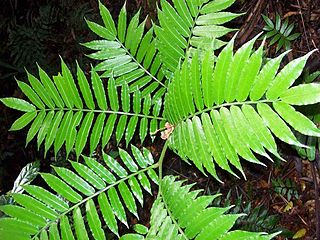
Marattiaceae is the only family of extant (living) ferns in the order Marattiales. In the Pteridophyte Phylogeny Group classification of 2016, Marattiales is the only order in the subclass Marattiidae. The family has six genera and about 110 species. Many are different in appearance from other ferns, having large fronds and fleshy rootstocks.

The United States Botanic Garden (USBG) is a botanical garden on the grounds of the United States Capitol in Washington, D.C., near the James A. Garfield Monument.

Epermeniidae or the fringe-tufted moths is a family of insects in the lepidopteran order with about 14 genera. Previously they have been divided in two subfamilies Epermeniinae and Ochromolopinae but this is no longer maintained since the last group is probably hierarchically nested within the first. They are presently placed in their own superfamily but have previously been placed among the Yponomeutoidea or Copromorphoidea with which they share some features. Their systematic placement among the apoditrysian group "Obtectomera" is however uncertain. They show some morphological similarities to the "plume moths", for example the wing fringe has similar groups of scales. There are also some similarities to Schreckensteinioidea, for example spiny legs and at least in some species an open-network cocoon. The genus Thambotricha from New Zealand may be the sister group of all other extant members. The most important genera are Epermenia, Ochromolopis and Gnathifera. The group has been extensively revised and catalogued by Dr Reinhard Gaedike.

Spilomelinae is a very species-rich subfamily of the lepidopteran family Crambidae, the crambid snout moths. With 4,135 described species in 344 genera worldwide, it is the most speciose group among pyraloids.

Scotorythra is a genus of moths in the family Geometridae erected by Arthur Gardiner Butler in 1883. All species of this genus are endemic to Hawaii.
The Arafura Jungles form a site with an area of about 5000 ha in eastern Arnhem Land, in the Top End of the Northern Territory of Australia. It contains twelve patches of monsoon vine forest of areas varying from 1.5 ha to 50 ha, representing four distinct floristic types, in the sandstone escarpment bordering the eastern edge of the Arafura Swamp, 12 km north of Mirrngadja. It is listed on the now-defunct Register of the National Estate.

Herpetogramma is a genus of moths in the family Crambidae described by Julius Lederer in 1863. It currently comprises 106 species that are found in North America, Eurasia, Australia, New Zealand, Central and South America. Of the few species where host plants are known, the larvae mostly feed on grasses.

Angiopteris is a genus of huge evergreen ferns from the family Marattiaceae, found throughout the paleotropics from Madagascar to the South Pacific islands. Species of smaller stature with elongate synangia and creeping rhizomes are sometimes segregated into the genus Archangiopteris, and a once-pinnate monotypic segregate genus has been called Macroglossum, but molecular data supports inclusion of these taxa within a broad concept of Angiopteris.

Angiopteris evecta, commonly known as the king fern, giant fern, elephant fern, oriental vessel fern, Madagascar tree fern, or mule's Foot fern, is a very large rainforest fern in the family Marattiaceae native to most parts of Southeast Asia and Oceania. It has a history dating back about 300 million years, and is believed to have the longest fronds of any fern in the world.

Herpetogramma licarsisalis, commonly known as the grass webworm or pale sod-webworm, is a species of moth in the family Crambidae.
Trigonoorda trygoda is a moth in the family Crambidae. It was described by Edward Meyrick in 1897. It is found in Australia, where it has been recorded from Queensland, New South Wales and Western Australia.
Herpetogramma cleoropa is a species of moth in the family Crambidae. It was described by Edward Meyrick in 1934. It is found on the Marquesas Archipelago, where it has been recorded from Hiva Oa.
Herpetogramma exculta is a species of moth in the family Crambidae. It was described by Thomas Pennington Lucas in 1892. It is found in Australia, where it has been recorded from Queensland.
Herpetogramma hipponalis is a species of moth in the family Crambidae. It was described by Francis Walker in 1859. It is found in Malaysia, China, the Keeling Islands, Guadalcanal, New Guinea and Australia, where it has been recorded from the Northern Territory and Queensland.

Herpetogramma luctuosalis is a species of moth in the family Crambidae. It was described by Achille Guenée in 1854. It is found in Siberia, Malaysia, India, Taiwan and China.
Herpetogramma phthorosticta is a species of moth in the family Crambidae. It was described by Edward Meyrick in 1929. It is found on the Marquesas Archipelago in French Polynesia.
Herpetogramma stultalis is a species of moth in the family Crambidae. It was described by Francis Walker in 1859. It is found in Malaysia, India, Sri Lanka, China, Japan, Pakistan, Papua New Guinea and Australia, where it has been recorded from Queensland. In Africa, it has been recorded from the Democratic Republic of the Congo and Réunion.

Herpetogrammatini is a tribe of the species-rich subfamily Spilomelinae in the pyraloid moth family Crambidae. The tribe was erected by Richard Mally, James E. Hayden, Christoph Neinhuis, Bjarte H. Jordal and Matthias Nuss in 2019.










